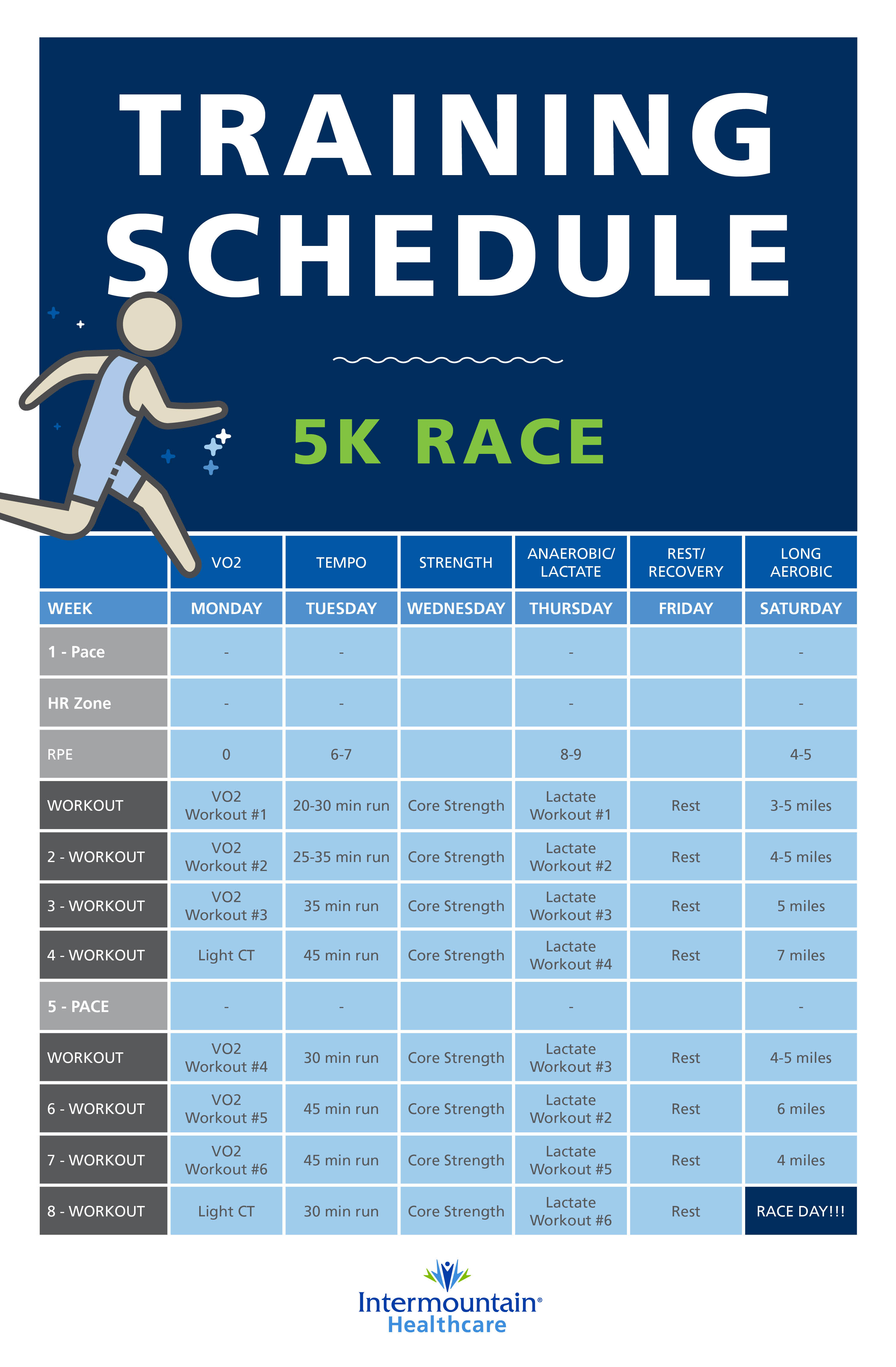This is a 5K training schedule for runners who run on a regular basis and want to improve their performance. Before using this schedule as your training guide, you should be able to run 2-3 miles without much discomfort. If not, give yourself some time to build up to that level gradually, or you may risk injury.
Remember, the schedule above is only a guide. Feel free to make minor modifications to suit your schedule. It's less important what you do in any one workout than what you do over the full eight weeks leading up to your 5K. The schedule includes a test 5K race halfway through the program. You could race more frequently, but too much racing may increase the risk of injury.
The 5K Workouts
- V02 Workout: After warming up, run hard, then rest, repeating several times. This helps your body use oxygen more efficiently. The rate of oxygen is your V02 max, or the maximum amount of oxygen your body can expend. As part of this training, you’ll do a fartlek workout, which is a mostly easy run, except you’ll sprint for periods of time, and then run easy again.
- Core Strength Workout: Do exercises that strengthen not only your abdominals, but also your back muscles and pelvis/hip. This workout is vital for performance, endurance, and injury prevention Be sure to include exercises that strengthen your buttock muscles, as a lot of running injuries, particularly the knee, happen due to relative weakness or fatigue in your hip/pelvis/core muscles.
- Lactate Workout: Shift from a slow, easy aerobic jog where you primarily use oxygen as your source of energy, to a higher intensity anaerobic pace that you can sustain for 15-20 minutes (or 5-10 minutes if you’re just starting out). During the anaerobic/lactate pace, you’ll primarily utilize carbohydrates for energy, and lactate is produced as a byproduct. This will help give you an alternative energy source when you’re exercising at higher intensity.
- Cross Training (CT): Try cycling, spinning, rowing, swimming, climbing, skiing, and other activities on this day.
Performance Indicators
- Heart Rate Zone (HR) and Pace are different from person to person. Please contact one of our running labs at Intermountain to be measured. In Northern Utah, running labs are located at McKay-Dee Sports Medicine, Bountiful Sports Medicine, and TOSH.
- Rate of Perceived Exertion (RPE) is a subjective measure of how hard you feel you are working at a given pace on a 0-10 scale. For example, an easy run would be 2-3; a tempo run 4-6, and a VO2 max workout in the 7-9 range.
How to Do the Workouts
VO2 Workouts: You should do these after an adequate warm up. If you want an additional workout, add 30 min of CT.
- 4 x 200m with 1 min recovery
- 3 x 200m with 1 min recovery, then 3 x 400m with 2 min recovery
- 30/30 fartlek:
- Alternate running 30 seconds at VO2 pace and 30 seconds at half that pace
- Continue until you can't sustain 30 seconds at VO2 pace
- 5 x 800m with 2 min recovery
- Pyramid set: 200m - 1 min (recovery) - 400m - 2 min - 800m - 3min - 400m - 2 min - 200m
- 3 sets of 4 x300/100 m
- Run 4 x 400m repeats. Run the first 300m at VO2 pace and the final 100m at all out sprint pace
- Recover x 1 min. Repeat 300/100 until you've done 4. Recover x 5 minutes. Repeat 4 times
Lactate Workouts:You should do these after an adequate warm up. Once you've done the lactate workout, run at mild-moderate pace until you've worked out for a total of 60 minutes.
- 1 mile repeats: Run 3 x 1 mile repeats at lactate pace with 2-4 minutes recovery in between
- 800m repeats: 6-7 x 800m repeats at lactate pace with 1-2 min of recovery between each repeat
- 3 x 400/1200m compound sets:
- Run 400m at just above VO2 pace. With no recovery, slow down to lactate pace for 1200m
- Recover with 2 minutes rest. Repeat 4 more times for a total of 5 compound sets
- 2-3 x 200/1600/200m compound sets:
- Run 200m at VO2 pace, then slow to lactate pace for 2000m (1 1/4 miles)
- Finish the set by kicking back up to VO2 pace for the last 200m
- Recover 3 minutes between each compound set.
- 2 x 12 min with 4 min recovery
- 2 x 5 min with 5 min recovery
5K Training Plan
A few key points to remember during your training:
Rest: You can't train hard unless you are well-rested. The schedule includes rest days and easier runs scheduled throughout the program. These will help you rest for harder/longer workouts on other days. The final week before the race is a taper down week. Tapering helps you get ready for a peak performance on race day.
Stretch & Strengthen: An important addition to any training program is stretching. Daily, routine stretching, which can be done a number of ways including foam rolling, helps promote mobility, circulation and overall well-being. Strength training is critical for runners! Do not forget this in your training. Traditional research suggests runners would generally benefit if they combine light weights with a high number of repetitions, rather than pumping very heavy iron. More recent data suggests this may not necessarily be true. The bottom line is strength training in any form is likely to be beneficial. Particularly focus on your glutes/buttock, hips, and core. Strength training can be combined with shorter/easier runs or done all on their own. Consistency is key.
Racing: Some racing is useful in helping you to peak. Consider doing some other races at 5-K to 10-K distances to test your fitness.
